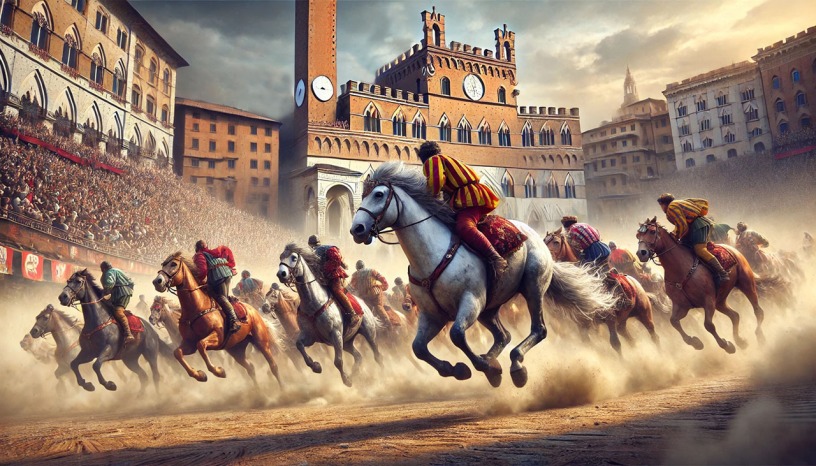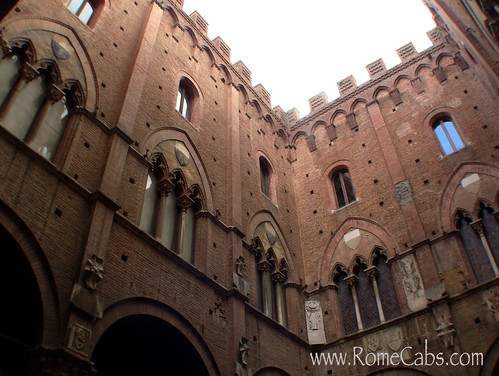This imagined day in the life of a Medieval Palio Rider in Siena is an imagined scenario based on historical events and practices in medieval Siena (Tuscany). While the descriptions of the Palio race, Siena, and its culture are inspired by real historical details, the characters, specific events, and personal experiences portrayed are fictionalized for storytelling purposes. Images are imagined scenarios for story-telling enhancements. Enjoy this journey through time.
The sun has barely begun to rise over Siena, and the city hums with the anticipation of the day ahead. It’s Palio day, and the streets are already alive with excitement, but for Tommaso, today feels like the most important day of his life. The weight of his contrada—the Lupa, the Wolf—is on his shoulders, and the outcome of the race will determine whether he returns as a hero or a disappointment.
He’s up before the first church bells toll, standing alone in the stable, brushing down his horse, Nero. The stallion shifts beneath his touch, sensing the same restless energy that keeps Tommaso’s heart racing in his chest. Today is not like other days.
Today is the Palio di Siena, the culmination of months of training, strategizing, and whispered prayers. He tightens the straps of Nero’s saddle, trying to steady his own nerves. This race will be brutal, as it always is. The Palio is not just a race—it’s a battle, and in Siena, there’s no greater honor than winning it.
.
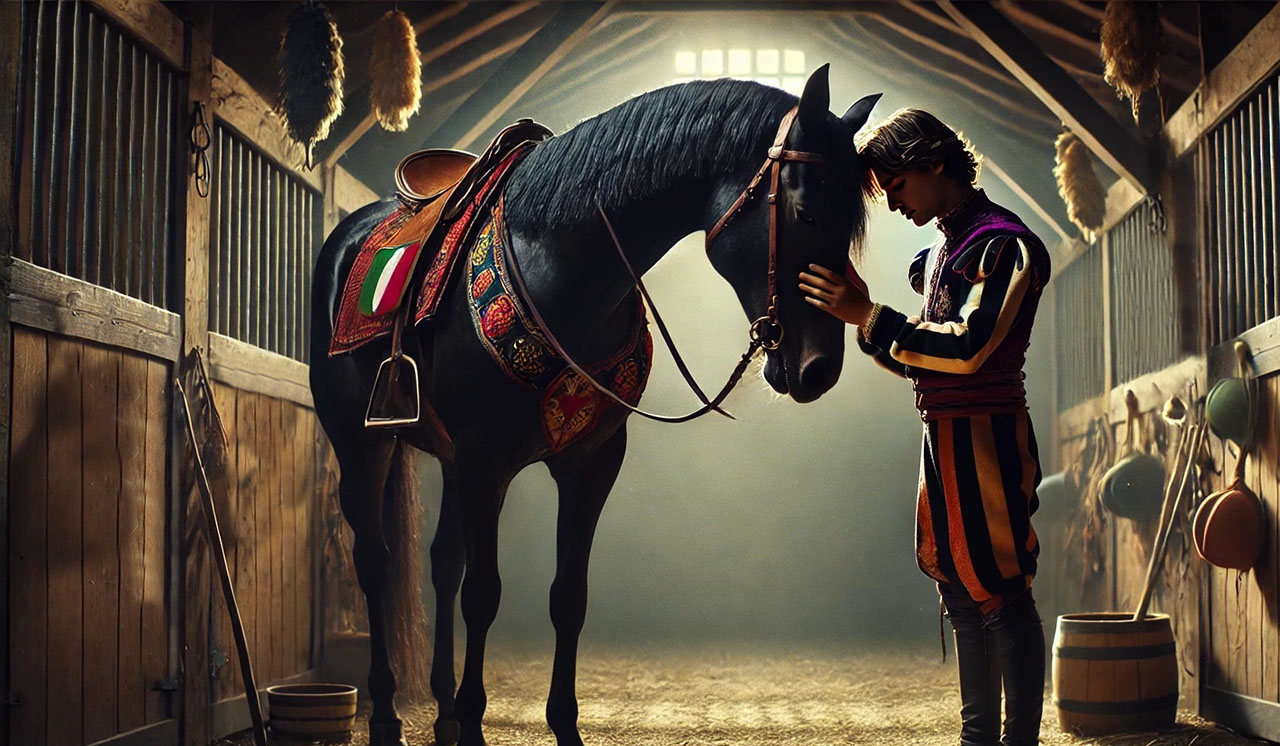
.
The Morning Preparations: A City of Wolves
.
The Lupa contrada lies in the shadow of Siena’s towering walls, its narrow streets winding like a maze through ancient stone buildings. It’s early, but the neighborhood is already awake, stirring with anticipation. The blue, black, and white banners of Lupa hang from every window, fluttering in the morning breeze. Today, more than any other day, the pride of the Wolf is at stake.
Tommaso walks through the streets toward the Piazza del Campo, the thundering of hooves soon to fill the vast, bowl-like square. His steps are heavy, each one drawing him closer to the fate that awaits him. As he moves, his neighbors call out to him, offering words of encouragement, their faces full of hope and expectation.
“Forza, Tommaso!” shouts an elderly woman, her hand clutching a string of rosary beads. She’s been in the contrada her whole life, and her voice cracks with emotion as she calls to him. For her, for all of them, this race is everything.
.
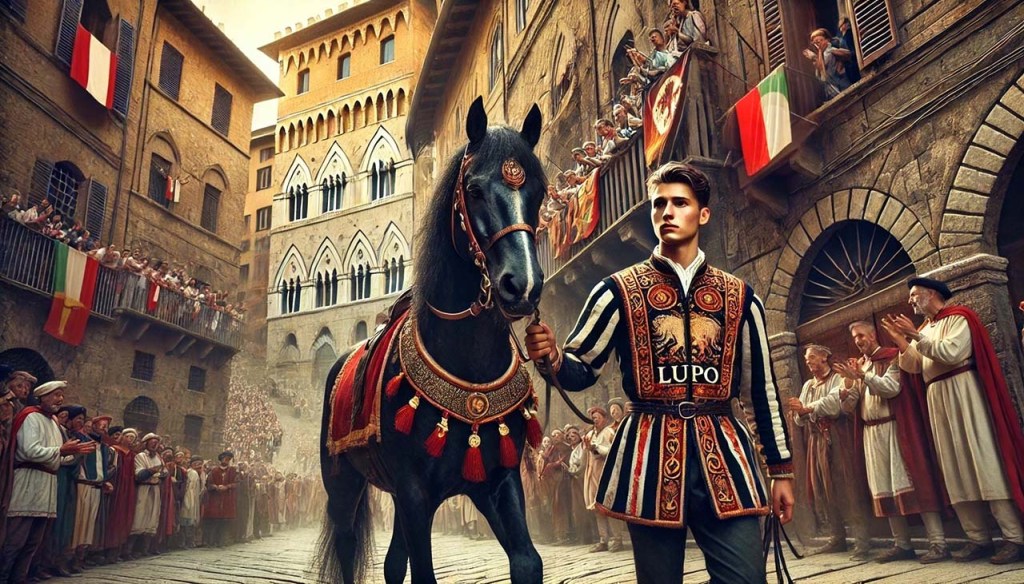
.
Tommaso nods, trying to absorb their faith in him. He can’t afford to falter today. The Lupa has not won in years, and rivalries have only grown fiercer. The Istrice (Porcupine) contrada and their rider are especially dangerous this year, and Tommaso knows they’ll do anything to win. This race isn’t just about speed—it’s about survival, strategy, and cunning, and today, the wolves of Lupa will need to outsmart their enemies.
.
Noon: The Weight of the Palio
By midday, the Piazza del Campo is a cauldron of energy. Thousands of spectators fill every inch of the square—rich nobles in their finest clothes, peasants, merchants, and foreign travelers all jostling for a view. The banners of all the contrade hang high, rippling in the breeze. Drums pound steadily, echoing through the streets like a heartbeat, and the Palio, the painted silk banner that will go to the victor, hangs in the Palazzo Pubblico like a glittering prize.
Tommaso stands with the other riders in the narrow alleyways that lead to the square. His heart races, not just with nerves, but with the ferocity of a wolf ready to pounce. His gaze drifts over the other riders—faces hardened by the same intensity. Each of them bears the hopes of their contrada, but only one will win.
.
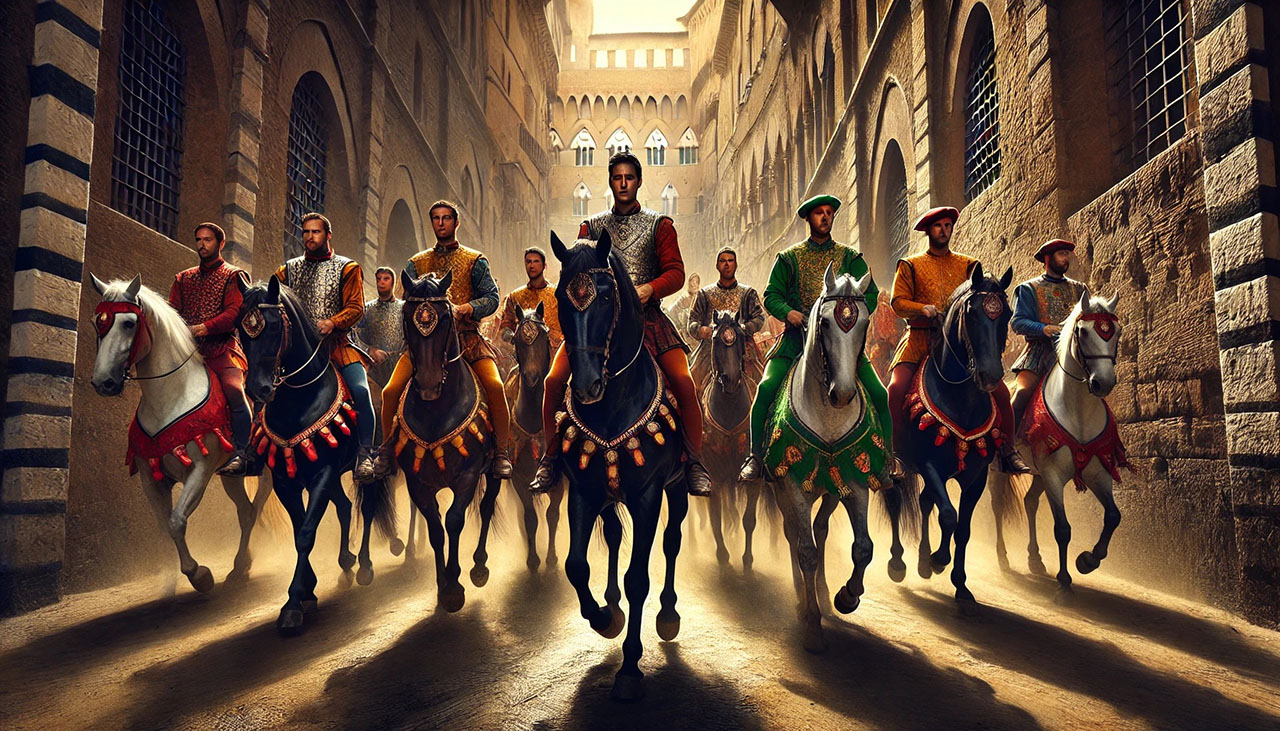
.
The air is heavy with tension, and he knows that today, more than any other day, alliances will be made and broken, and blood might be spilled.
As the mossa, the chaotic starting line, is called, Tommaso feels a rush of adrenaline. The horses are lined up, their flanks shimmering with sweat, muscles taut. Nero paws the ground, ready to explode into motion. Tommaso reaches down, tightening his grip on the reins, his fingers shaking slightly. The Palio is dangerous—riders have been thrown, trampled, and injured in the chaos before. Today, he could become one of them.
But that thought vanishes as the signal is given.
.
The Race: Wolves Among Lions
The sound that erupts as the race begins is deafening. The crowd roars, a wave of sound that crashes over the riders as they hurtle forward. Nero leaps beneath Tommaso, muscles surging with raw power as they fly into the tight turns of the Piazza del Campo. The first lap is a blur of hooves and dust, as riders jostle for position, their horses neck and neck, muscles straining.
.
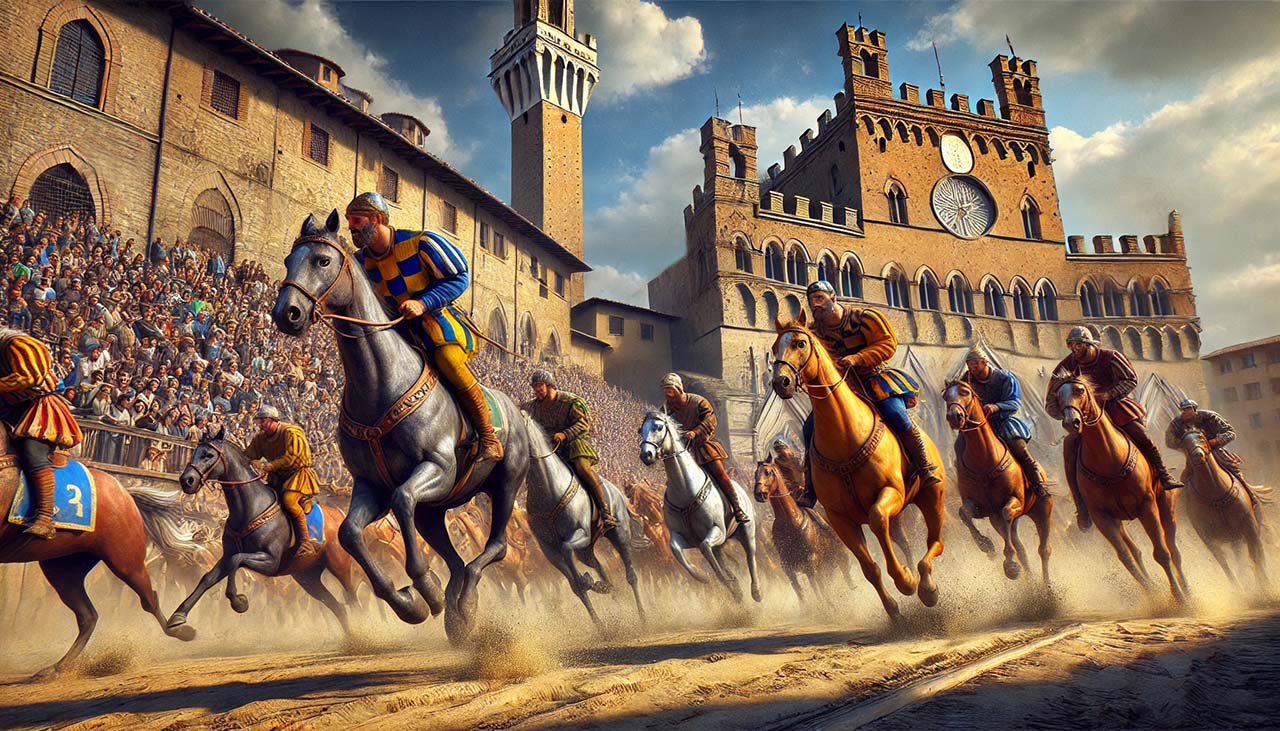
.
Tommaso’s eyes are locked ahead, focused on the sharp bends and narrow paths of the track. The turns are treacherous—walls seem to fly toward him as he pulls Nero sharply to the side, his body moving with the horse. Behind him, the rider from Tartuca crashes against the wall, and Tommaso doesn’t look back. This is the Palio—there’s no room for mercy.
The second lap is even more brutal. The riders have begun to attack each other, their whips lashing not just at their own horses but at their rivals’. Tommaso ducks as the rider from Istrice swings at him, narrowly missing his face. For a heartbeat, he can feel the pulse of panic—one wrong move, one strike too hard, and he’ll be thrown from his horse.
.
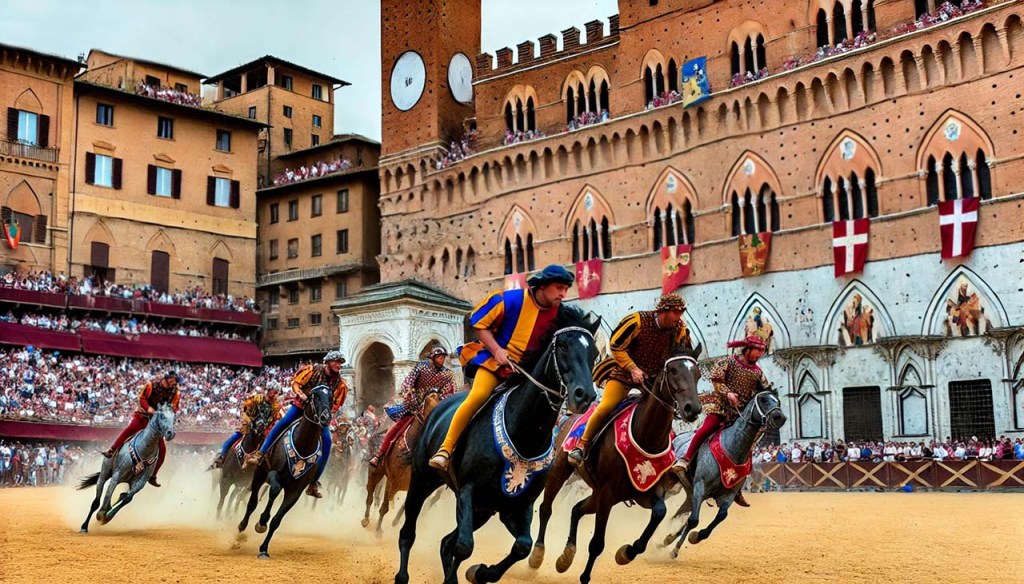
.
But the Lupa rider has a wolf’s instincts. He leans into the next curve, Nero’s hooves pounding the packed earth, his mind racing faster than his body. This is what they’ve trained for—months of grueling preparation, hours spent perfecting his technique for this very moment.
He knows that Nero can feel it too—the stallion’s heart beats in time with his own, and together, they are a force of nature.
On the final lap, Tommaso feels the roar of the crowd like a wave crashing behind him. The Istrice rider is still too close for comfort, but Tommaso pushes Nero harder, feeling the horse’s muscles strain beneath him.
His eyes are locked on the finish line, the colors of the Giraffa and Aquila riders fading in his peripheral vision. There’s nothing but the sound of hooves pounding the earth, the wind tearing past his ears, and the heavy breath of his horse.
The crowd erupts in a frenzy, cheering and shouting with all their might, each voice rising in passionate support of their contrada’s rider
.

.
Victory or Defeat?
The final turn is where races are won or lost. Tommaso knows that he can’t afford to hesitate. He pulls hard on the reins, feeling Nero’s body twist into the turn. The crowd is deafening now, a cacophony of screaming voices, and for a split second, time seems to slow.
Then he sees it—the finish line, just ahead. Tommaso leans forward, urging Nero with every last ounce of strength he has. His legs burn, his chest tightens, but he can’t stop now.
.
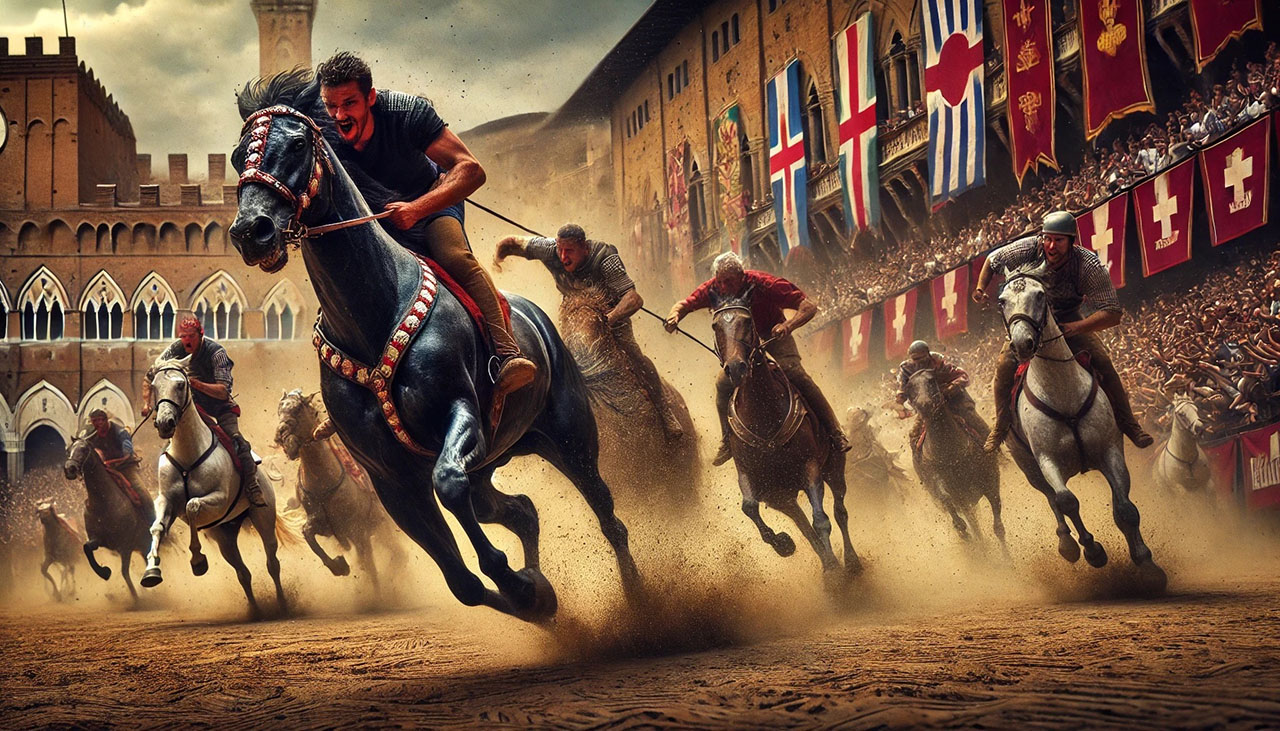
.
The finish comes in a blur of dust and sweat. Nero crosses the line, and Tommaso’s heart explodes in his chest. He hears the screams of the crowd, feels the weight of what’s just happened sink in. They’ve won. Lupa has won.
For a moment, the world spins around him. He barely feels the hands of his fellow contradaioli lifting him from the horse, their cheers filling the air. His legs tremble as he’s hoisted onto their shoulders, carried through the streets like a conquering hero. The Palio banner, the Drappellone, is paraded before them, the prize for which they fought tooth and nail.
In this moment, Tommaso is not just a man. He is the wolf—fierce, triumphant, and unstoppable. And for the people of the Lupa contrada, today will be remembered in stories for generations to come.
.
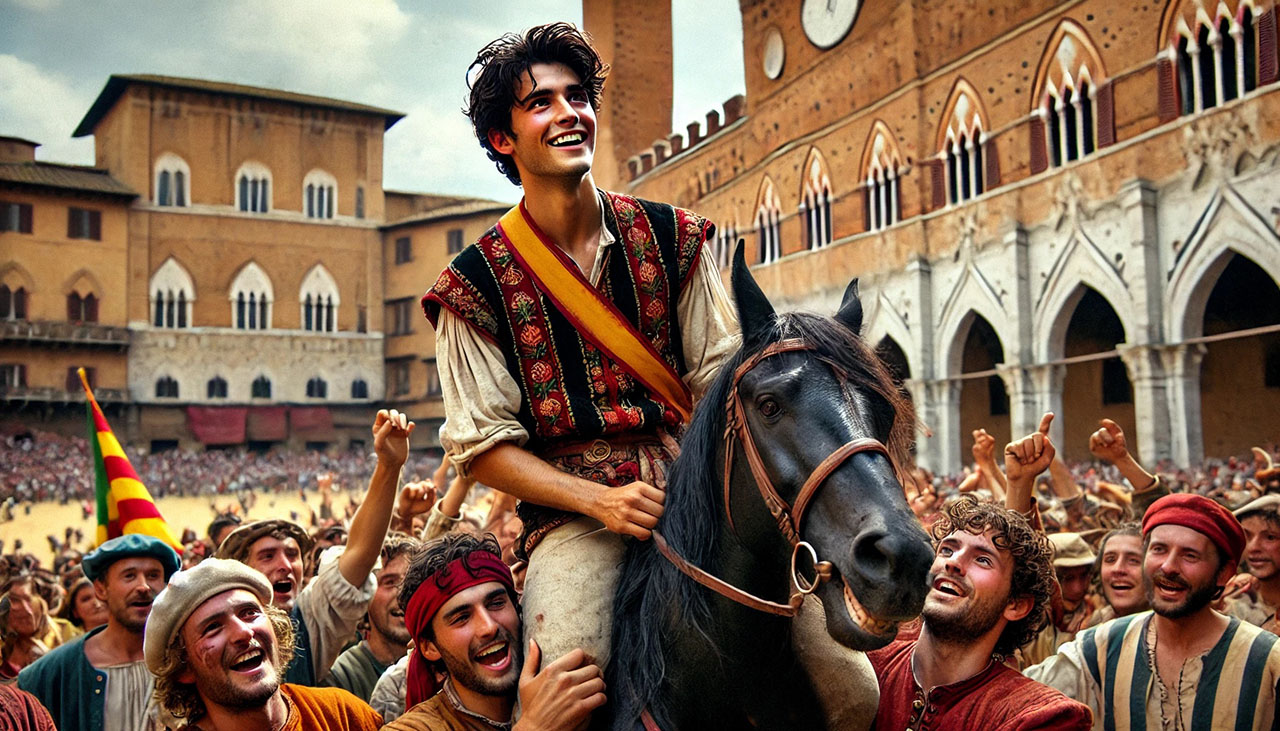
.
The Real Palio di Siena: A Tradition of Fierce Rivalry and Pride
.
While this story takes you into an imagined day in the life of a Palio rider, the Palio di Siena is very real—and remains one of the most thrilling and historic events in Italy. The Palio, which dates back to at least the 13th century, was originally a series of games and contests held during the Feast of the Assumption in honor of the Virgin Mary, Siena’s beloved patron saint. Over time, these contests evolved into the horse race we know today, symbolizing the fierce rivalry between Siena’s 17 contrade (districts).
The modern Palio takes place twice a year, on July 2nd (the Palio di Provenzano) and August 16th (the Palio dell’Assunta). These dates correspond to the celebrations of the Madonna of Provenzano and the Assumption of the Virgin Mary, respectively. The race, held in the stunning Piazza del Campo, lasts only around 90 seconds, but the excitement, preparation, and rivalry build for months in advance.
Even today, the Palio is much more than just a horse race. It’s a centuries-old tradition, deeply ingrained in the identity of Siena’s people, where honor, pride, and belonging are at stake, just as they were for the riders of medieval times.
.
.
If you’re planning a trip to Siena to witness the thrilling Palio firsthand or simply want to explore this enchanting medieval city as part of your Italian adventure, RomeCabs offers Transfers from Fiumicino Airport or Rome to Siena.
Enjoy a hassle-free journey in comfort with RomeCabs, allowing you to relax and take in the beautiful Tuscan countryside while traveling to your destination with ease. With RomeCabs, your trip to Siena will be smooth, convenient, and stress-free, so you can focus on immersing yourself in the rich history and culture that awaits!
Thank you for reading our blog and Happy Travels!
RomeCabs Team ~
.
Find RomeCabs also online:
RomeCabs Facebook: https://www.facebook.com/RomeCabsToursAndTransfers
RomeCabs Pinterest: https://www.pinterest.it/romecabs
RomeCabs Twitter: https://twitter.com/RomeCabs
RomeCabs Instagram: https://www.instagram.com/romecabs/
RomeCabs Flickr Photo Gallery: https://www.flickr.com/photos/romecabs/
.
.
.
.
.
.
.
